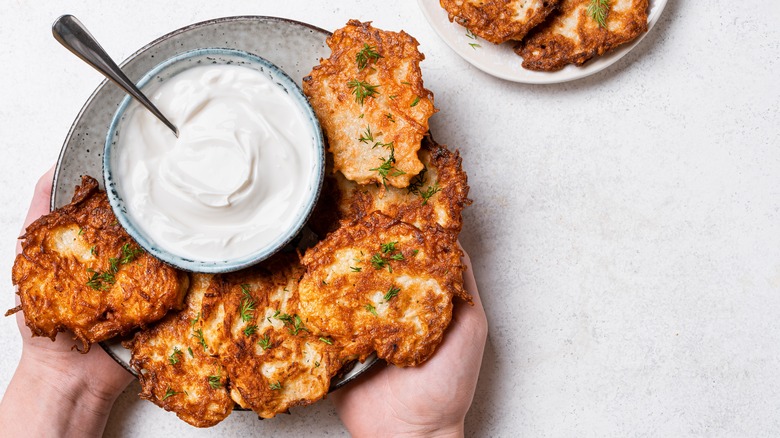Why You Shouldn't Throw Away The Residual Potato Liquid When Making Latkes
Jewish classics like challah bread, kugel, and delightful sufganiyot jelly donuts all appear on the Hanukkah spread. Yet a food especially essential to the holiday is a serving of latkes. These fried shredded potato pancakes even function as an ode to the celebration's origins. The Festival of Lights celebrates when a small amount of oil miraculously lit a temple's menorah for eight days. So accordingly, frying the dish in oil commemorates such a tradition.
As a result, knowing how to make latkes is all about managing the spud on an oily pan. And a crucial step is squeezing out the contained liquid before cooking. Eliminating the moisture will enhance the frying, achieving an extra crispy result. Once you're done, don't throw away the residual potato liquid. Instead, let the starch separate, and settle to the bottom. Integrate this squeezed solid back into the latke mixture, and you'll be rewarded with extra crispiness. It's a technique that craftily makes use of kitchen waste, while enhancing the result in the process.
Add the squeezed-out starch back into the latke mix
Similarly to knowing how to make legitimately crispy French fries at home, crafting delicious latkes is all about understanding starch. The carbohydrate develops a specific structure when exposed to heat. As it releases water, the structure turns hard, yet not dense, with openings between bonds. This results in the characteristic crunchy texture that's a selling point of latkes.
Adding the starch that's escaped only furthers such a construction, reinforcing the brittle crust the dish is known for. When looking at the dense sediment, it's easy to forget it's the same as the potato starch sold standalone, which amplifies a range of dishes. So double down on the resultant latke crispiness, and fry up batches to an ideally crispy state. Serve with a sour cream, which can even be homemade with heavy cream, and you have yourself an ideal take on the Hanukkah classic.

